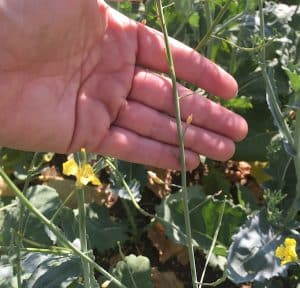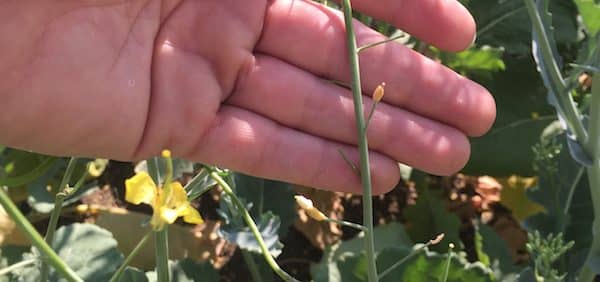Hot, dry weather reduces infection rates and the progression of sclerotinia within the plant. The disease risk is limited when current conditions are dry, max daily temps are 30°C or more, and forecast is for this to continue for seven to 14 days.
Hot weather can also increase flower and pod abortion, which could reduce overall yield potential. Return on investment from a fungicide applications is more likely if yield loss is at least 3 bu./ac., which may not occur under hot, dry conditions. Likelihood of a return increases with higher yields, especially since conditions for higher yields also favour disease development.

If a field has regular rains or high humidity or both from two to three weeks before flowering and through flowering, this will get spore-releasing apothecia going in time to be active during flowering. If moist conditions continue after flowering, severity of the disease could be high and yield loss significant. Morning dew is a good indicator of ample humidity. Walk through the field in the morning. If your pants get wet, there’s enough moisture for sclerotinia.
Even on hot days, a canola canopy can have its own more-moist micro-climate. Also keep in mind that even though the sclerotinia pathogen does not like to grow over temperatures of 30°C, lower night temperatures will allow for fungal growth. Fungicide may still provide a return.
With these conditions and average or better yield potential, a fungicide application at 20-30% flower is warranted. When considering fungicide cost ($14 to $25 per acre, depending on the product) and application ($7 per acre for custom ground, $11 for aerial), a fungicide would have to preserve around 3 bu./ac. of yield to break even.
Spray performance in hot weather. Note that hot conditions can reduce fungicide performance by increasing evaporation of the spray droplets. Some companies say to avoid spraying in temperatures above 25-27°C, but that may not be necessary for all fungicides. Check with the supplier. A tip is to keep the water volumes at a minimum of 10 gallons per acre and droplets in the coarse range. This will help to reduce rapid droplet evaporation while still maintaining very good target coverage.
Late-window scenario. If conditions were hot and dry before flowering, then turn moist during flowering, the economic return from fungicide could be higher with a late-window application (around 50% flower). This would be especially true if moisture also promoted a longer flowering window due to later compensatory growth. With lower seeding rates resulting in more branching, canola fields can be at 50% flower for a week or more. Keep in mind however that infection to side branches tends to have a lower overall effect on yield than infection on main stems, and that late-window applications for some products may be close to their pre-harvest intervals.
Base the spray decision on this year’s conditions, not last year’s experience. Growers can feel burned by prior years’ experience with spray decisions for sclerotinia. Use prior years’ experience as a guide, but make this year’s decision based on this year’s conditions.
Dig deeper
Sclerotinia risk assessment tool
NDSU sclerotinia risk map
Canola Encyclopedia sclerotinia stem rot
Sclerotinia management: Common questions

